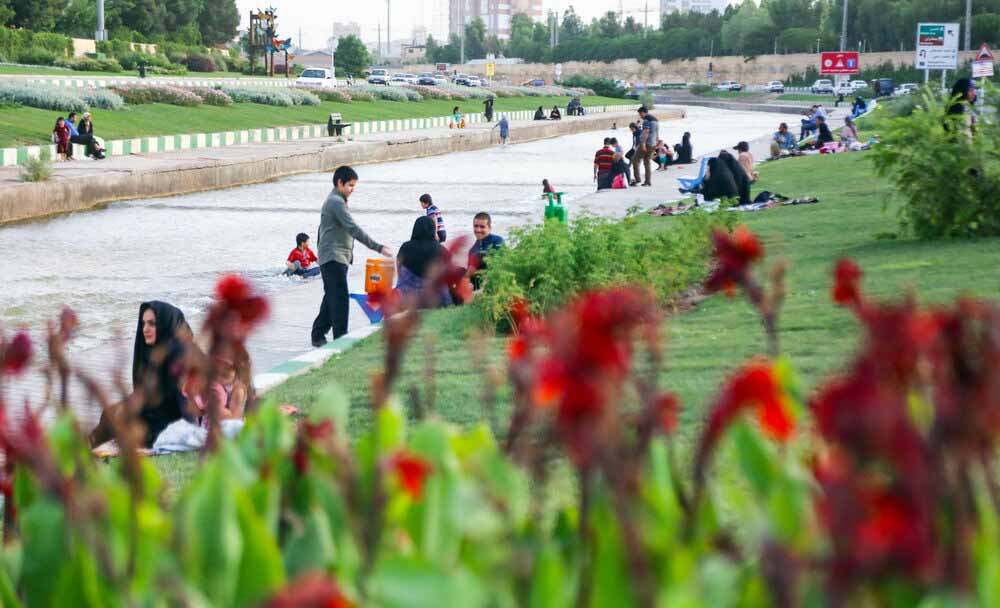حمید صادقی
کتاب تاریخ قم نوشته حسن بن محمد قمی از علمای سال چهارم هجری به دلیل دقت نظر و شرح مطالب در میان کتابهای تاریخنگاری شهری از جایگاهی ممتاز برخوردار است. در خلال مباحث تاریخ قم به دفعات از رودخانه قم و نحوه ایجاد آن سخن به میان آورده است.
بهتازگی مباحثی در خصوص نام رودخانه قم مطرح شده که نام صحیح رودخانه قم “انار بار” بوده و عنوان قمرود بر رودخانه قم خطا است. همین مباحث تشکیکی باعث شد مطالب ذیل با برداشتهایی از کتاب تاریخ قم عرضه گردد:
“روایت کردهاند از ناحیت تیمره … آب از آن بیرون میآید و از آنجا به قم میرود و هر گاه آب رودخانه قم زیاده بر احتیاج ضیعتهای حوالی قم بودی آن زیاد را به قم روان کردندی پس آن آب به قمرود به موضعی که آن را صحرای مسیله خوانند فرو میرفت.”
از همین حکایت وجه تسمیه قم را جستجو نمودهاند؛ چه این که قم مجمع آبهای تیمره بوده که ایجاد مرغزار نموده و شبانان را به آنجا جلب و کومهها ایجاد شده و معرب کومه را قم گفتهاند.
برخی نیز گویند آب کبرود (به ضم کاف، ناحیتی در گلپایگان) در قم جمع شده سپس کب را معرب و قم گفتهاند. هر دو روایت قم اولیه را جایی میدانند که محل اجتماع آب زیادی بوده است. در بسیاری موارد رودخانهها نام محلهایی که از آن عبور میکرده بر خود میگرفته است مانند؛ برقرود، کاسرود، طهرانرود. قمرود نیز از این قاعده مستثنی نیست. لذا وقتی رودخانه به جایی به نام قم رسیده است نام قمرود گرفته است. لذا اصل و اساس قم را به نوعی میتوان رستاق قمرود دانست. جایی که بر اثر کشفیات باستانی چندین هزار سال پیش از میلاد مسیح قدمت دارد. خاستگاه نام قم همین منطقه است. بعدها دیههایی در دو طرف رودخانه احداث گردیده و نام شهر را خاستگاه تاریخی قمرود رقم زده است.
در خصوص تعمیم و تسری نام رودخانه قمرود شاهدی از تاریخ قم میآوریم:
“اشاعره برستاق کمیدان که از جمله آخرین رستاقهای اصفهان بود که پس از آن بیابانی است متصل به ری و قومس و بر کنار رودخانه کمیدان که او را در این ساعت قمرود میخوانند نزول کردهاند.”
این خود دلیلی است قوی بر این که نامیدن رودخانه قم به قمرود موافق تاریخ قم است. به نظر همین تسری نام رودخانه در خصوص شهر نیز رخ داده است و نام قم بر نامهای رقیب مانند مالون، ممجان، کمیدان، جمکران و غیره غلبه نموده است. مشاهده نگردید که مولف تاریخ قم از “رودخانه انار بار” ذکری گفته باشد. مواضعی که نام “انار بار” را ذکر نموده رستاق اناربار است.
دیگر این که در کتاب تاریخ قم از اساس پیدایش رودخانه قم را از سرچشمه تیمره و برقرود و چشمه کبرود دانسته که بعدها معرب گردیده و قمرود شده است. لذا قمرود عنوان عام رودخانهای است که از کبرود تیمره جاری گشته است. این نیز دلیل دوم بر اطلاق عنوان قمرود به رودخانه قم که درست مینماید.
نکته دیگر این که مولف تاریخ قم در خیلی جاها از کلمه “رودخانهها” که جمع است استفاده نموده است. به نظر میرسد در قدیم انشعاباتی وجود داشته که هر کدام را رود مینامیدند:
“در جویهایی که از سر رودخانهها برگرفته بودند.” ذکر چندین باره “میانرودان” نیز از قرائن این مطلب میتواند باشد.
از آنچه گذشت این نتایج به دست میآید:
۱. قدیمیترین رودخانه قم عتیق نام داشته که به حکایت تاریخ قم بر اثر رسوب و گل و لای آب آن به زیر افتاده و آثارش هم اکنون در سراجه روبهروی باغ زمانزاده قابل مشاهده است.
۲. قمرود عنوان عامی ست برای رودی که از تیمره و برقرود به قم رسیده است.
۳. رودخانه قم نام واحدی نداشته و به هر موضع که میرسیده نام آن موضع را میگرفته است. اما تاریخ قم به کرات از قمرود که آن ایام دیگر نامی عام برای رودخانه گردیده بود نام برده است.
۴. در کتاب تاریخ قم به عنوان “رودخانه اناربار” برنمیخوریم. میتوانیم به قسمتی که رود از مجاورت شهر میگذشته (حدود خاکفرج و میدان مطهری کنونی) به طور خاص رودخانه کمیدان گوییم که در اثر مرور زمان قمرود نام گرفته است.
۵. عنوان “رود اناربار” پس از ترجمه تاریخ قم ایجاد گردیده و در دوره معاصر توسط مصححین کتب در ضمن حاشیهنویسی بسط داده شده است.
۶. گاهی در ازمنه مختلف رودخانه قمرود نامهای دیگری به فراخور سلیقه به خود گرفته است؛ همچنان که در کتاب “سفر در ایران”، نوشته گاسپار دروویل از رودخانه قم با نام “چهار باغ” یادشده است. تفصیل این مطلب در یادداشتی جداگانه خواهد آمد.
۹۹/۱۰/۲۲
Hamid Sadeghi
The book of the history of Qom written by Hassan Ibn Mohammad Qomi, one of the scholars of the fourth year of AH, has a special place among the books of urban historiography due to its careful consideration and description of the contents. During the history of Qom, he has repeatedly talked about the Qom River and how it was created. Recently, there have been discussions about the name of Qom river, which is the correct name of Qom river “Anar Bar” and the title of Qamroud on Qom river is wrong. These skeptical issues led to the following material being presented with excerpts from the history book of Qom: “You sent Ziad to Qom, then the water to Qamrud would sink to a place called the Masila Desert.” From this story, they have searched for the name of Qom; What is more, Qom was the assembly of the waters of Timura, which created a meadow and attracted shepherds there, and ridges were created and the name of the ridge was called Qom. Some also say that the water of Kabroud (in addition to Kaf, an area in Golpayegan) was collected in Qom, and then Kab was called Mo’rab and Qom. Both narrations consider early Qom to be a place where a lot of water was collected. In many cases, rivers bear the names of the neighborhoods through which they flow, such as; Barghrud, Kasrud, Tehranrud. Qamroud is no exception to this rule. Therefore, when the river reached a place called Qom, it was named Qamroud. Therefore, the origin of Qom can be considered as Rustaq Qamroud. Where, according to ancient discoveries, dates back several thousand years BC. The origin of the name Qom is this region. Later, diyats were built on both sides of the river and the name of the city is the historical origin of Qomroud. Regarding the generalization and expansion of the name of Qamroud river, we bring testimony from the history of Qom: Have.” This is a strong reason why naming the Qom River as Qamroud agrees with the history of Qom. It seems that the same name of the river has been applied to the city and the name of Qom has overcome the rival letters such as Maloon, Mamjan, Kamidan, Jamkaran, and so on. It was not observed that the author of the history of Qom mentioned the “Pomegranate River”. The positions that mention the name “Anar Bar” are Rustaq Anarbar. Another is that in the history book of Qom, based on the origin of the Qom river, it is considered to be the source of Timura, Barghroud, and Cheshmeh Kabroud, which were later converted to Qamrud. Therefore, Qamroud is the general title of a river that has flowed from Kabroud Teymareh. This is the second reason why the name Qamrud refers to the Qom River, which is correct. Another point is that the author of the history of Qom has used the word “rivers” which is plural in many places. It seems that in ancient times there were tributaries, each of which was called a river: “in the streams that flowed from the rivers.” Mentioning “Mesopotamia” several times can also be evidence of this. From the following, the following results are obtained: The oldest river in Qom is called Atiq, which according to the history of Qom has been submerged due to sediment and mud, and its traces can now be seen in Sarajeh in front of Zamanzadeh Garden. ۲. Qamrud is a common title for a river that reached Qom from Timur and Barqrud. 3. The Qom River did not have a single name, and it took the name of each place is reached. But the history of Qom has repeatedly mentioned Qamrud, which in those days had become a common name for the river. 4. In the history book of Qom, we do not eat it as “Anarbar river”. We can say that the part of the river that passed near the city (around Khakfaraj and the current Motahhari Square) is specifically the Kamidan River, which was named Qamroud due to the passage of time. 5. The title “Anarbar River” was created after the translation of the history of Qom and in the contemporary period it has been expanded by book proofreaders while annotating. 6. Sometimes in different parts of Qomroud river, other letters have been taken according to taste; As mentioned in the book “Journey in Iran”, written by Gaspar Drewville, the Qom River is called “Chahar Bagh”. Details of this will be provided in a separate note. 99



